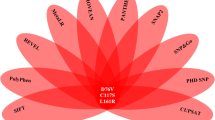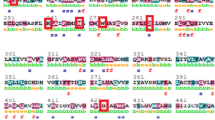Abstract
Single-Nucleotide Polymorphisms (SNPs) are common genetic variations implicated in human diseases. The non-synonymous SNPs (nsSNPs) affect the proteins’ structures and their molecular interactions with other interacting proteins during the accomplishment of biochemical processes. This ultimately causes proteins functional perturbation and disease phenotypes. The Insulin receptor substrate-2 (IRS-2) protein promotes glucose absorption and participates in the biological regulation of glucose metabolism and energy production. Several IRS-2 SNPs are reported in association with type 2 diabetes and obesity in human populations. However, there are no comprehensive reports about the protein structural consequences of these nsSNPs. Keeping in view the pathophysiological consequences of the IRS-2 nsSNPs, we designed the current study to understand their possible structural impact on coding protein. The prioritized list of the deleterious IRS-2 nsSNPs was acquired from multiple bioinformatics resources, including VEP (SIFT, PolyPhen, and Condel), PROVEAN, SNPs&GO, PMut, and SNAP2. The protein structure stability assessment of these nsSNPs was performed by MuPro and I-Mutant-3.0 servers via structural modeling approaches. The atomic-level structural and molecular dynamics (MD) impact of these nsSNPs were examined using GROMACS 2019.2 software package. The analyses initially predicted 8 high-risk nsSNPs located in the highly conserved regions of IRS-2. The MD simulation analysis eventually prioritized the N232Y, R218C, and R104H nsSNPs that predicted to significantly compromise the structure stability and may affect the biological function of IRS-2. These nsSNPs are predicted as high-risk candidates for diabetes and obesity. The validation of protein structural impact of these shortlisted nsSNPs may provide biochemical insight into the IRS-2-mediated type-2 diabetes.






Similar content being viewed by others
Data Availability
All data generated or analyzed during this study are included in this published article and its supplementary information files.
References
Adzhubei I, Jordan DM, Sunyaev SR (2013) Predicting functional effect of human missense mutations using PolyPhen-2. Curr Protoc Hum Genet 76(1):7201–72041
Almind K, Frederiksen S, Bernal D et al (1999) Search for variants of the gene-promoter and the potential phosphotyrosine encoding sequence of the insulin receptor substrate-2 gene: evaluation of their relation with alterations in insulin secretion and insulin sensitivity. Diabetologia 42(10):1244–1249
Ashkenazy H, Abadi S, Martz E et al (2016) ConSurf 2016: an improved methodology to estimate and visualize evolutionary conservation in macromolecules. Nucleic Acids Res 44(W1):W344–W350
Ayaz L, Karakaş Çelik S, Cayan F (2014) The G1057D polymorphism of insulin receptor substrate-2 associated with gestational diabetes mellitus. Gynecol Endocrinol 30(2):165–168
Biasini M, Bienert S, Waterhouse A et al (2014) SWISS-MODEL: modelling protein tertiary and quaternary structure using evolutionary information. Nucleic Acids Res 42(W1):W252–W258
Biovia DS (2017) Discovery studio visualizer. San Diego
Calabrese R, Capriotti E, Fariselli P, Martelli PL, Casadio R (2009) Functional annotations improve the predictive score of human disease-related mutations in proteins. Hum Mutat 30(8):1237–1244
Capriotti E, Fariselli P, Casadio R (2005) I-Mutant2.0: predicting stability changes upon mutation from the protein sequence or structure. Nucleic Acids Res 33(suppl_2):W306–W310
Cheng J, Randall A, Baldi P (2006) Prediction of protein stability changes for single-site mutations using support vector machines. Proteins 62(4):1125–1132
Choi Y (2012) A fast computation of pairwise sequence alignment scores between a protein and a set of single-locus variants of another protein. Proceedings of the ACM Conference on Bioinformatics, Computational Biology and Biomedicine, pp 414–417.
Choi Y, Chan AP (2015) PROVEAN web server: a tool to predict the functional effect of amino acid substitutions and indels. Bioinformatics 31(16):2745–2747
Dabhi B, Mistry KN (2014) In silico analysis of single nucleotide polymorphism (SNP) in human TNF-α gene. Meta Gene 2:586–595
Dakal TC, Kala D, Dhiman G, Yadav V, Krokhotin A, Dokholyan NV (2017) Predicting the functional consequences of non-synonymous single nucleotide polymorphisms in IL8 gene. Sci Rep 7(1):1–18
Dobson RJ, Munroe PB, Caulfield MJ, Saqi MA (2006) Predicting deleterious nsSNPs: an analysis of sequence and structural attributes. BMC Bioinform 7(1):1–9
Franceschini A (2013) STRINGdb Package Vignette. Nucleic Acids Res
Fritsche A, Madaus A, Renn W et al (2001) The prevalent Gly1057Asp polymorphism in the insulin receptor substrate-2 gene is not associated with impaired insulin secretion. J Clin Endocrinol Metab 86(10):4822–4825
Gfeller D, Ernst A, Jarvik N, Sidhu SS, Bader GD (2014) Prediction and experimental characterization of nsSNPs altering human PDZ-binding motifs. PLoS ONE 9(4):e94507
González-Pérez A, López-Bigas N (2011) Improving the assessment of the outcome of nonsynonymous SNVs with a consensus deleteriousness score, Condel. Am J Hum Genet 88(4):440–449
Hecht M, Bromberg Y, Rost B (2015) Better prediction of functional effects for sequence variants. BMC Genom 16(8):1–12
Heo L, Park H, Seok C (2013) GalaxyRefine: protein structure refinement driven by side-chain repacking. Nucleic Acids Res 41(W1):W384–W388
Laing R et al (2011) The role and impact of SNPs in pharmacogenomics and personalized medicine. Curr Drug Metab 12(5):460–486
Laskowski RA (2009) PDBsum new things. Nucleic Acids Res. 37(suppl1):D355–D359
Laskowski R, MacArthur M, Thornton J (2006) PROCHECK: validation of protein-structure coordinates
Lee YH, White MF (2004) Insulin receptor substrate proteins and diabetes. Arch Pharmacal Res 27(4):361–370
López-Ferrando V, Gazzo A, De La Cruz X, Orozco M, Gelpí JL (2017) PMut: a web-based tool for the annotation of pathological variants on proteins, 2017 update. Nucleic Acids Res 45(W1):W222–W228
Loureiro LO, Engstrom MD, Lim BK (2020) Single nucleotide polymorphisms (SNPs) provide unprecedented resolution of species boundaries, phylogenetic relationships, and genetic diversity in the mastiff bats (Molossus). Mol Phylogenet Evol 143:106690
Lyonnais PB (2010) Sopma secondary structure prediction method
Machado-Neto JA, Fenerich BA, Rodrigues Alves APN et al (2018) Insulin Substrate Receptor (IRS) proteins in normal and malignant hematopoiesis. Clinics 73:e566
McLaren W, Gil L, Hunt SE et al (2016) The ensembl variant effect predictor. Genome Biol 17(1):1–14
Muoio DM, Newgard CB (2008) Molecular and metabolic mechanisms of insulin resistance and β-cell failure in type 2 diabetes. Nat Rev Mol Cell Biol 9(3):193–205
Ng PC, Henikoff SJ (2001) Predicting deleterious amino acid substitutions. Genome Res 11(5):863–874
Ng PC, Henikoff S (2003) SIFT: predicting amino acid changes that affect protein function. Nucleic Acids Res 31(13):3812–3814
Ng PC, Henikoff S (2006) Predicting the effects of amino acid substitutions on protein function. Annu Rev Genom Hum Genet 7:61–80
Rajith B (2011) Path to facilitate the prediction of functional amino acid substitutions in red blood cell disorders–a computational approach. PLoS ONE 6(9):e24607
Razzini G, Ingrosso A, Brancaccio A, Sciacchitano S, Esposito DL, Falasca M (2000) Different subcellular localization and phosphoinositides binding of insulin receptor substrate protein pleckstrin homology domains. Mol Endocrinol 14(6):823–836
Saltiel AR, Kahn CR (2001) Insulin signalling and the regulation of glucose and lipid metabolism. Nature 414(6865):799–806
Sherry ST, Ward M-H, Kholodov M et al (2001) dbSNP: the NCBI database of genetic variation. Nucleic Acids Res 29(1):308–311
Teng S, Michonova-Alexova E, Alexov EJ (2008) Approaches and resources for prediction of the effects of non-synonymous single nucleotide polymorphism on protein function and interactions. Curr Pharm Biotechnol 9(2):123–133
Thakur R, Shankar J (2016) In silico analysis revealed high-risk single nucleotide polymorphisms in human pentraxin-3 gene and their impact on innate immune response against microbial pathogens. Front Microbiol 7:192
Wang H, Rissanen J, Miettinen R et al (2001) New amino acid substitutions in the IRS-2 gene in Finnish and Chinese subjects with late-onset type 2 diabetes. Diabetes 50(8):1949–1951
Acknowledgements
The authors acknowledge the financial support of Higher Education Commission (HEC), Pakistan under the research grant NRPU-7438.
Funding
Funding was funded by Higher Education Commision, Pakistan, 7438, Asifullah Khan.
Author information
Authors and Affiliations
Contributions
A.Z & A.K conceived the basic research idea. A.Z, S.S, and S.G.A contributed to data analyses. A.Z. & M.S prepared the manuscript’s initial draft. A.K finalized the draft and supervised the entire study.
Corresponding author
Ethics declarations
Conflict of interest
All the authors declare no conflict of interest existence relevant to this study.
Additional information
Publisher's Note
Springer Nature remains neutral with regard to jurisdictional claims in published maps and institutional affiliations.
Supplementary Information
Below is the link to the electronic supplementary material.
Rights and permissions
About this article
Cite this article
Zia, A., Shams, S., Shah, M. et al. Structural Consequences of IRS-2 nsSNPs and Implication for Insulin Receptor Substrate-2 Protein Stability. Biochem Genet 61, 69–86 (2023). https://doi.org/10.1007/s10528-022-10247-y
Received:
Accepted:
Published:
Issue Date:
DOI: https://doi.org/10.1007/s10528-022-10247-y




